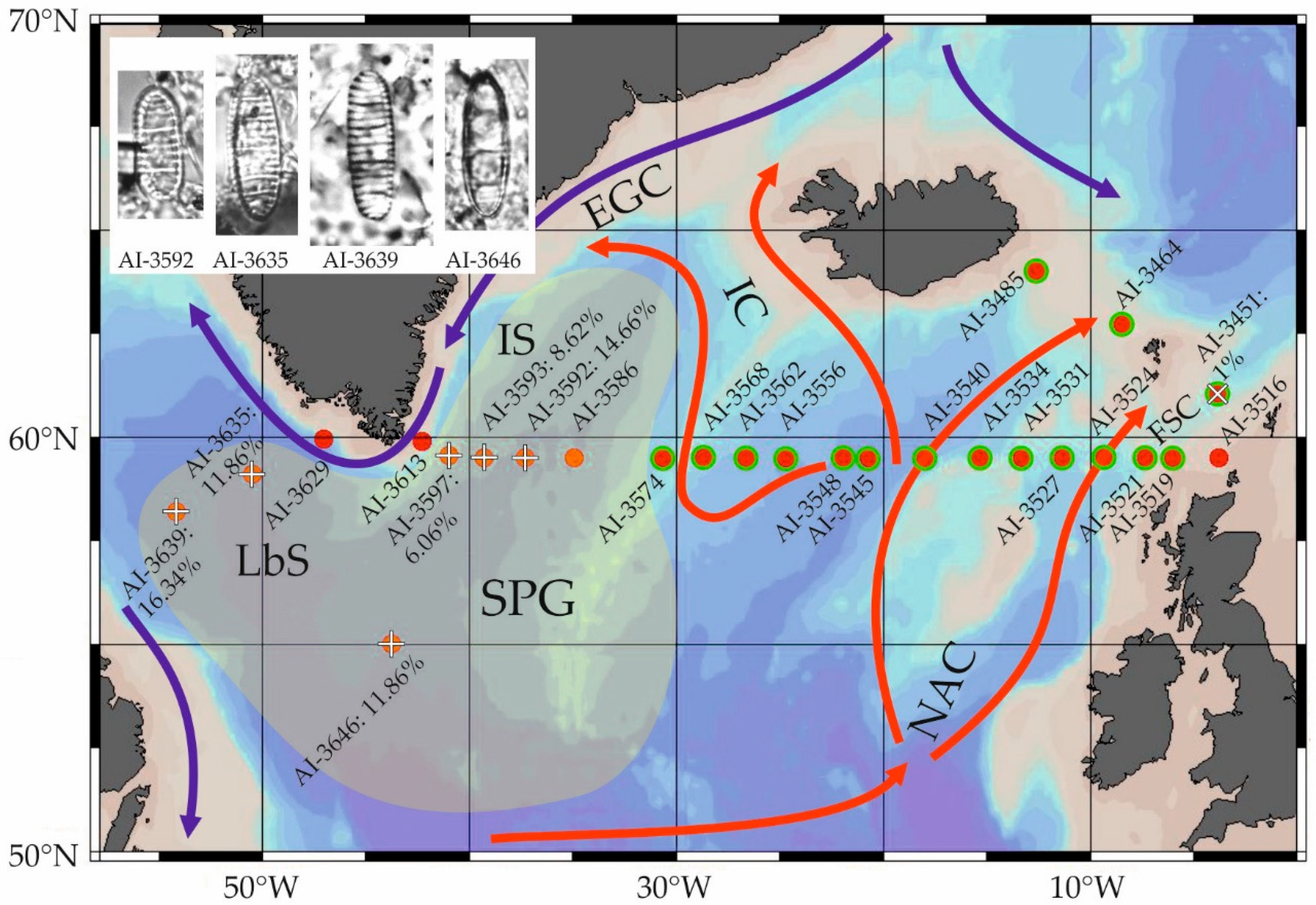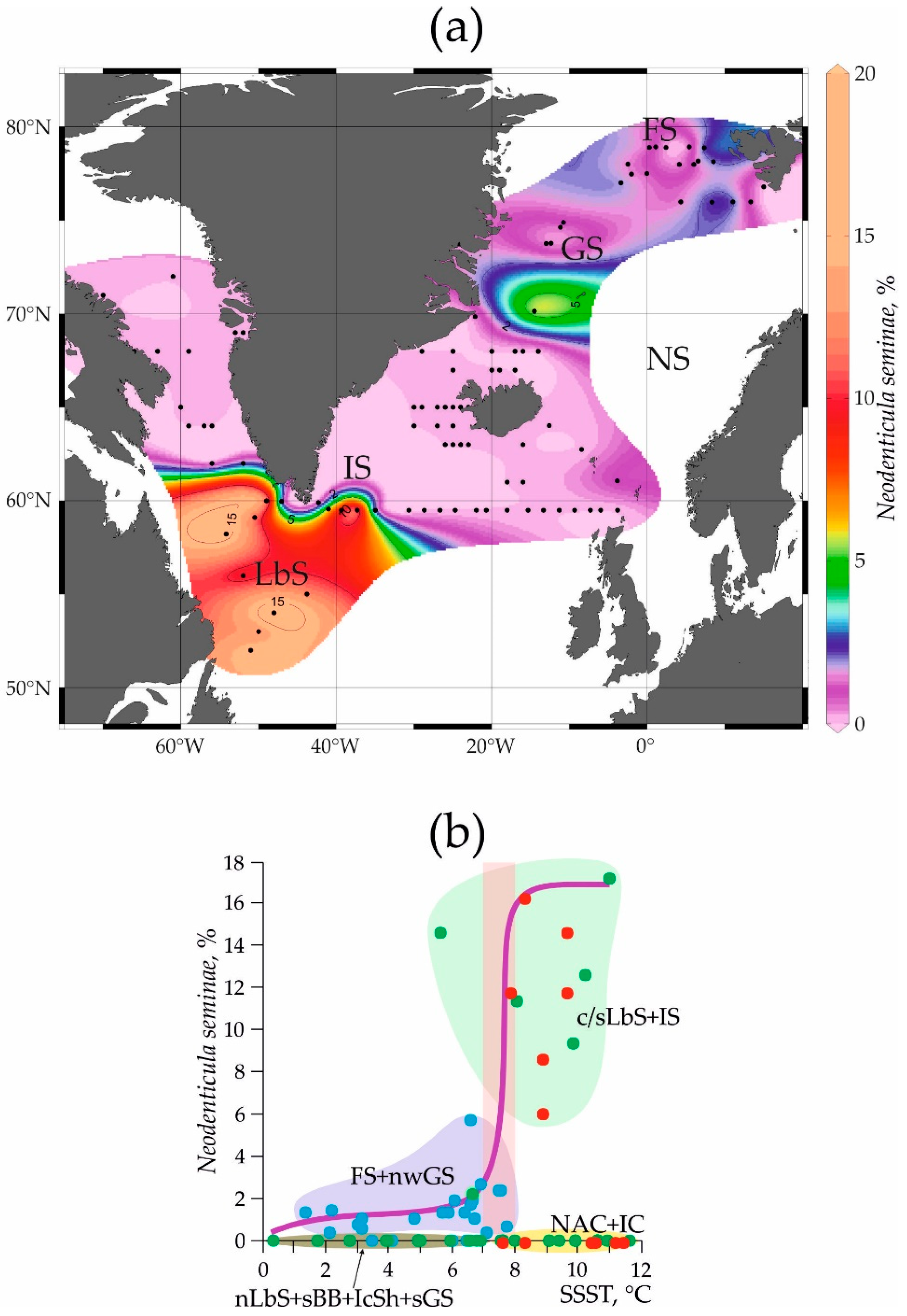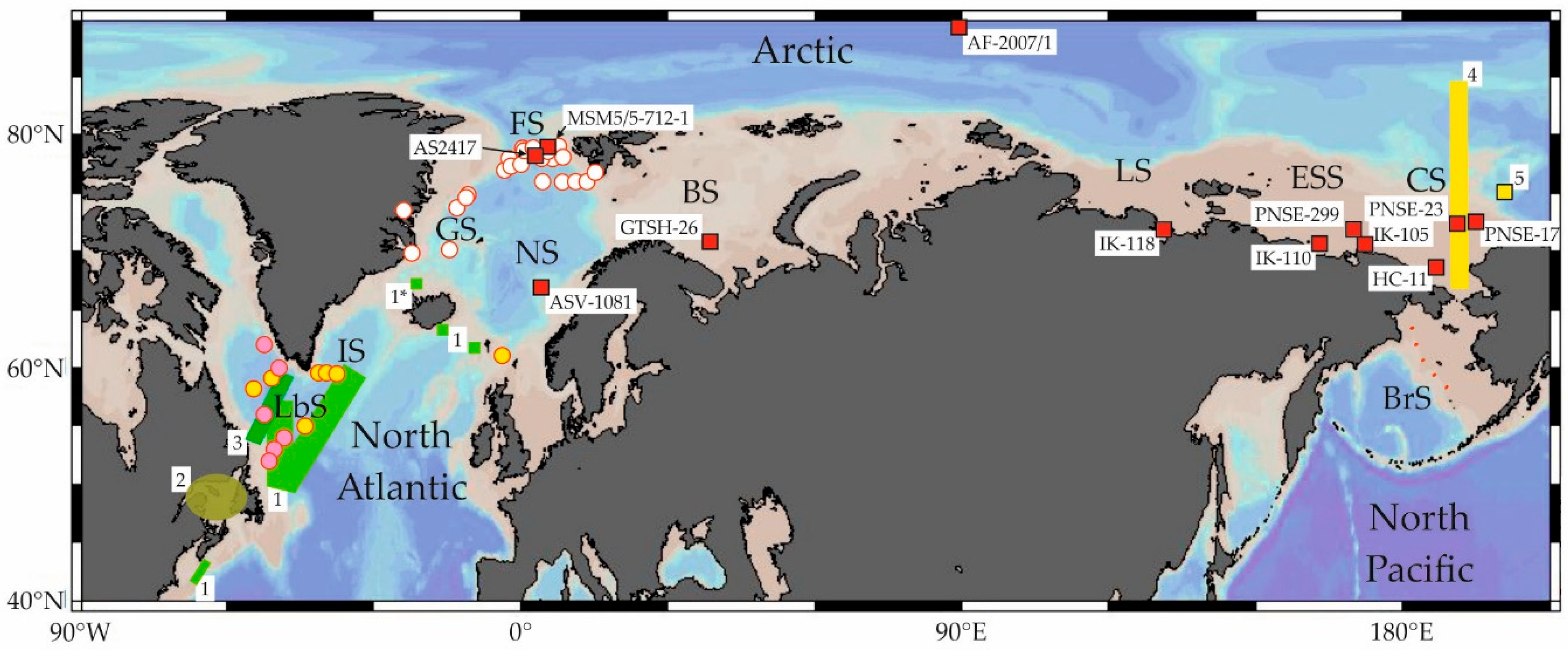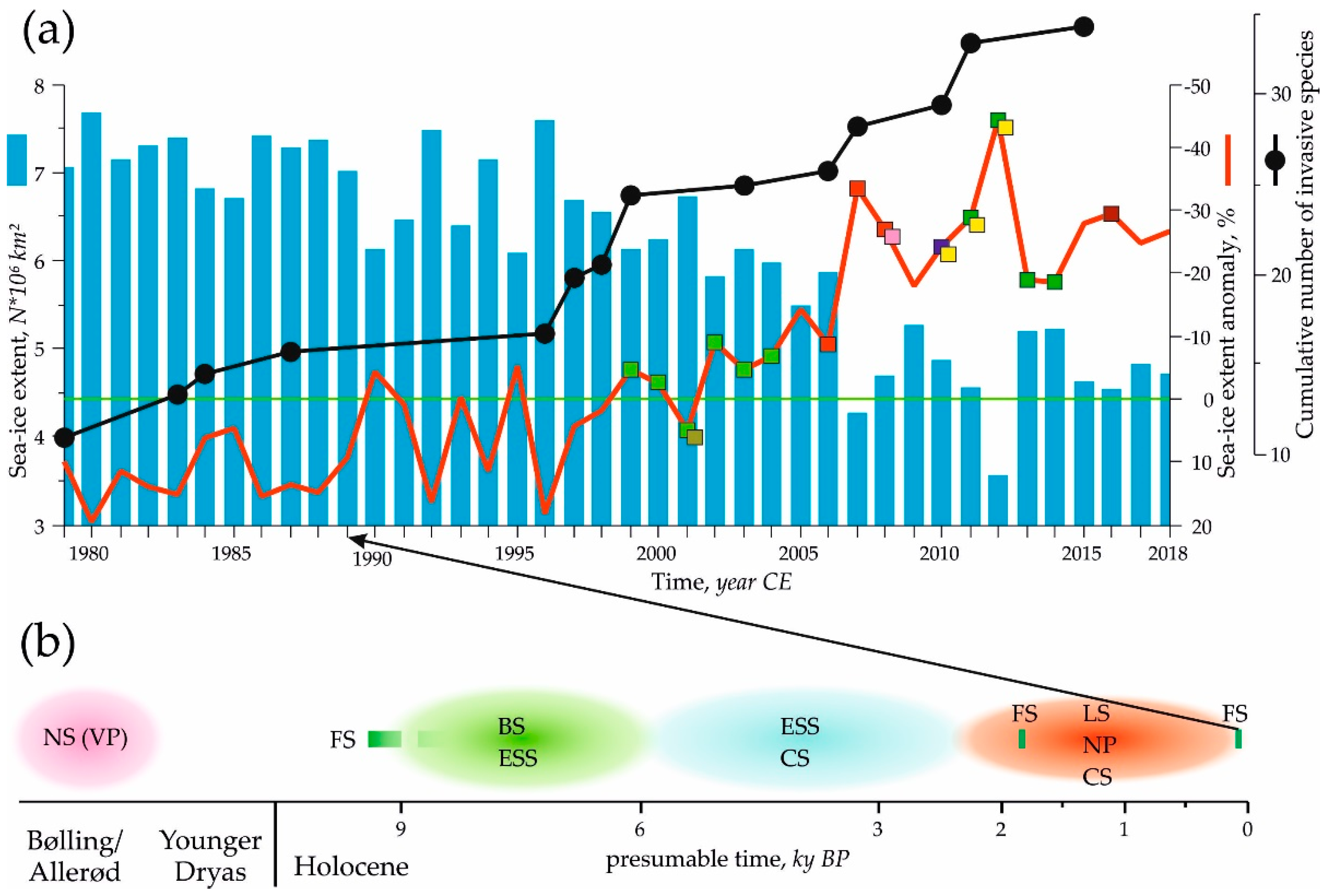The North Pacific Diatom Species Neodenticula seminae in the Modern and Holocene Sediments of the North Atlantic and Arctic
Abstract
:1. Introduction
2. Diatom Species Neodenticula seminae in the Modern Ocean
3. Diatom Species Neodenticula seminae in the Holocene Sediments of the Nordic and Arctic Seas
4. Migration of the Native North Pacific Diatom Species Neodenticula seminae to the North Atlantic as a possible Reflection of the Global Climate Change
Author Contributions
Funding
Acknowledgments
Conflicts of Interest
Appendix A
| Latitude | Longitude | Station | N. seminae, % |
|---|---|---|---|
| 55.0021 | −43.7569 | AI-3646 | 11.86 |
| 58.2180 | −54.1686 | AI-3639 | 16.34 |
| 59.1116 | −50.5108 | AI-3635 | 11.86 |
| 59.9664 | −47.0353 | AI-3629 | 0 |
| 59.8962 | −42.3150 | AI-3613 | 0 |
| 59.5627 | −41.0077 | AI-3597 | 6.06 |
| 59.5028 | −39.3311 | AI-3593 | 8.62 |
| 59.4926 | −37.3242 | AI-3592 | 14.66 |
| 59.5039 | −34.9820 | AI-3586 | 0 |
| 59.5062 | −30.6606 | AI-3574 | 0 |
| 59.5009 | −28.6663 | AI-3568 | 0 |
| 59.4988 | −26.6601 | AI-3562 | 0 |
| 59.4977 | −24.7053 | AI-3556 | 0 |
| 59.4931 | −21.9865 | AI-3548 | 0 |
| 59.4984 | −20.6946 | AI-3545 | 0 |
| 59.5004 | −18.0003 | AI-3540 | 0 |
| 59.5028 | −15.3330 | AI-3534 | 0 |
| 59.5009 | −13.3339 | AI-3531 | 0 |
| 59.4991 | −11.3338 | AI-3527 | 0 |
| 59.4988 | −9.3336 | AI-3524 | 0 |
| 59.5001 | −7.3344 | AI-3521 | 0 |
| 59.4996 | −6.0041 | AI-3519 | 0 |
| 59.5001 | −3.8321 | AI-3516 | 0 |
| 61.0679 | −3.8666 | AI-3451 | sporadic specimen, but accepted as 1% to draw Figure 2a |
| 62.7388 | −8.4601 | AI-3464 | 0 |
| 64.0252 | −12.6182 | AI-3485 | 0 |
References
- Renaut, S.; Devred, E.; Babin, M. Northward expansion and intensification of phytoplankton growth during the early ice-free season in Arctic. Geophys. Res. Lett. 2018, 45, 10590–10598. [Google Scholar] [CrossRef] [Green Version]
- Intergovernmental Panel on Climate Change (IPCC). Fourth Assessment Report of the Intergovernmental Panel on Climate Change, IPCC (WG I&II); Cambridge University Press: Cambridge, UK, 2007; 976p. [Google Scholar]
- Gascard, J.C.; Zhang, J.; Rafizadeh, M. Rapid Decline of Arctic Sea Ice Volume: Causes and Consequences. Cryosphere 2019. [Google Scholar] [CrossRef] [Green Version]
- Fernandez, L.; Kaiser, B.A.; Vestergaard, N. Marine invasive species in the Arctic. TemaNord 2014, 547. [Google Scholar] [CrossRef] [Green Version]
- Stachowicz, J.J.; Terwin, J.R.; Whitlatch, R.B.; Osman, R.W. Linking climate change and biological invasions: Ocean warming facilitates nonindigenous species invasions. Proc. Natl. Acad. Sci. USA 2002, 99, 15497–15500. [Google Scholar] [CrossRef] [Green Version]
- Occhipinti-Ambrogi, A.; Savini, D. Biological invasions as a component of global change in stressed marine ecosystems. Mar. Pollut. Bull. 2003, 46, 542–551. [Google Scholar] [CrossRef]
- Starr, M.; Harvey, M.; Galbraith, P.S.; Gilbert, D.; Chabot, D.; Therriault, J.C. Recent intrusion of Labrador Shelf waters into the Gulf of St. Lawrence and its influence on the plankton community and higher trophic levels. In Theme Session on Environmental Influence on Trophic Interactions (N); CM 2002/N: 16; International Council for the Exploration of the Sea: Copenhagen, Denmark, 2002. [Google Scholar]
- Reid, P.C.; Johns, D.G.; Edwards, M.I.N.; Starr, M.; Poulin, M.; Snoeijs, P. A biological consequence of reducing Arctic ice cover: Arrival of the Pacific diatom Neodenticula seminae in the North Atlantic for the first time in 800,000 years. Glob. Change Biol. 2007, 13, 1910–1921. [Google Scholar] [CrossRef]
- Miettinen, A.; Koç, N.; Husum, K. Appearance of the Pacific diatom Neodenticula seminae in the northern Nordic Seas—An indication of changes in Arctic sea ice and ocean circulation. Mar. Micropaleontol. 2013, 99, 2–7. [Google Scholar] [CrossRef]
- Matul, A.G.; Abelmann, A. Pleistocene and Holocene distribution of the radiolarian Amphimelissa setosa Cleve in the North Pacific and North Atlantic: Evidence for water mass movement. Deep-Sea Res. II 2005, 52, 2351–2364. [Google Scholar] [CrossRef]
- Bjørklund, K.R.; Hatakeda, K.; Kruglikova, S.B.; Matul, A.G. Amphimelissa setosa (Cleve) (Polycystina, Nassellaria)—A stratigraphic and paleoecological marker of migrating polar environments in the northern Hemisphere during the Quaternary. Stratigraphy 2015, 12, 233–237. [Google Scholar]
- Sha, L.; Jiang, H.; Seidenkrantz, M.S.; Knudsen, K.L.; Olsen, J.; Kuijpers, A.; Liu, Y. A diatom-based sea-ice reconstruction for the Vaigat Strait (Disko Bugt, West Greenland) over the last 5000 yr. Palaeogeogr. Palaeoclimat. Palaeoecol. 2014, 403, 66–79. [Google Scholar] [CrossRef]
- Schlitzer, R. Ocean Data View. 2018. Available online: https://odv.awi.de (accessed on 22 March 2020).
- Fragoso, G.M. Biogeography of Spring Phytoplankton Communities from the Labrador Sea: Drivers, Trends, Ecological Traits and Biogeochemical Implications. Ph.D. Thesis, University of Southampton, Southampton, UK, November 2016; 187p. (In Russian). [Google Scholar]
- Wang, Y.; Xiang, P.; Kang, J.; Ye, Y.; Lin, G.; Yang, Q.; Lin, M. Microphytoplankton community structure in the western Arctic Ocean: Surface layer variability of geographic and temporal considerations in summer. Hydrobiologia 2018, 811, 295–312. [Google Scholar] [CrossRef]
- Onodera, J.; Watanabe, E.; Harada, N.; Honda, M.C. Diatom flux reflects water-mass conditions on the southern Northwind Abyssal Plain, Arctic Ocean. Biogeosciences 2015, 12, 1373–1385. [Google Scholar] [CrossRef] [Green Version]
- Polyakova, Y.I. The Eurasian Arctic Seas during the Late Cenozoic; Scientific World: Moscow, Russia, 1997; 145p. [Google Scholar]
- Gusev, E.A.; Skolotnev, S.G.; Aleksandrova, G.N.; Bylinskaya, M.E.; Golovina, L.A.; Zaporozhets, N.I.; Laiba, A.A.; Lyapunoiv, S.M.; Radionova, E.P. Preliminary Results of the Study of Deep-Sea Sediments from the North Pole. Dokl. Earth Sci. 2008, 421, 897–901. [Google Scholar] [CrossRef]
- Mukhina, V.V.; Dmitrenko, O.B. Microfossils in the upper Quaternary sediments of the Norwegian Sea (biostratigraphy and paleoceanology). Oceanology 2008, 48, 720–734. [Google Scholar] [CrossRef]
- Bylinskaya, M.E.; Golovina, L.A.; Radionova, E.P.; Pokrovskii, B.G.; Lavrushin, V.Y. Paleoenvironments in the Fram Strait during Marine Isotope Stages 2–6 based on planktonic paleobiological and stable-isotope proxies and ice-rafted debris. Quat. Intern. 2016, 420, 272–279. [Google Scholar] [CrossRef]
- Tsoy, I.B.; Obrezkova, M.S. Atlas of Diatom Algae and Silicoflagellates from Holocene Sediments of the Russian East Arctic Seas; V.I. Il’ichev Pacific Oceanological Institute branch Russian Academy of Sciences: Vladivostok, Russia, 2017; 145p. (In Russian) [Google Scholar]
- Tsoy, I.B.; Obrezkova, M.S.; Aksentov, K.I.; Kolesnik, A.N.; Panov, V.S. Late Holocene Environmental Changes in the Southwestern Chukchi Sea Inferred from Diatom Analysis. Russ. J. Mar. Biol. 2017, 43, 276–285. [Google Scholar] [CrossRef]
- Matul, A.; Spielhagen, R.F.; Kazarina, G.; Kruglikova, S.; Dmitrenko, O.; Mohan, R. Warm-water events in the Fram Strait during the last 2000 years as revealed by different microfossil groups. Polar Res. 2018, 37. [Google Scholar] [CrossRef] [Green Version]
- Locarnini, R.A.; Mishonov, A.V.; Baranova, O.K.; Boyer, T.P.; Zweng, M.M.; Garcia, H.E.; Reagan, J.R.; Seidov, D.; Weathers, K.; Paver, C.R.; et al. NOAA Atlas NESDIS 81. World Ocean Atlas 2018, Volume 1: Temperature; NOAA/NESDIS National Centers for Environmental Information: Silver Spring, MD, USA, 2019; p. 52. [Google Scholar]
- Semina, G.I. A new species of genus Denticula Ktz. Bot. Contrib. Komar. Bot. Inst. USSR Acad. Sci. Div. Spore Plants 1956, 11, 82–84. (In Russian) [Google Scholar]
- Karohji, K. Report from the “Oshoro maru” on oceanographic and biological investigations in the Bering Sea and northern North Pacific in the summer of 1955. IV. Diatom associations as observed by Underway Samplings. Bull. Fish. Sci. Hokkaido Univ. 1959, 9, 259–267. [Google Scholar]
- Taniguchi, A.; Saito, K.; Koyama, A.; Fukuchi, M. Phytoplankton Communities in the Bering Sea and Adjacent Seas. I. Communities in Early Warming Season in Southern Areas. J. Oceanogr. Soc. Jpn. 1976, 32, 99–106. [Google Scholar] [CrossRef]
- Alexander, V.; Cooney, R.T. Ice edge ecosystem study: Primary productivity, nutrient cycling, and organic matter transfer. In Final Report, Outer Continental Shelf Environmental Assessment Program, Research Unit 427; University of Alaska: Fairbanks, AK, USA, 1979; p. 166. [Google Scholar]
- Phifer, L.D. The occurrence and distribution of plankton diatoms in the Bering Sea and Strait, July 26-August 24, 1934. In Report Oceanographic Cruise, U.S. Coast Guard Cutter Chelan, Bering Sea and Bering Strait, 1934, Part II(A); U.S. Goast Guard Headquarters: Washington, DC, USA, 1936; pp. 1–44. [Google Scholar]
- Aizawa, C.; Tanimoto, M.; Jordan, R.W. Living diatom assemblages from North Pacific and Bering Sea surface waters during summer 1999. Deep-Sea Res. II 2005, 52, 2186–2205. [Google Scholar] [CrossRef]
- Wang, Y.; Xiang, P.; Ye, Y.; Lin, G.; Yang, Q.; Lin, H.; Lin, M. Community structure and spatial-temporal variation of netz-phytoplankton in the Bering Sea in summer. Acta Oceanol. Sin. 2016, 35, 99–107. [Google Scholar] [CrossRef]
- Obrezkova, M.S.; Tsoy, I.B. Diatom flora of the Holocene sediments of the East Arctic seas. Vestnik Dal’nevostochnogo Otdelenija Rossijskoj Akademii Nauk 2008, 1, 136–143. (In Russian) [Google Scholar]
- Ren, J.; Gersonde, R.; Esper, O.; Sancetta, C. Diatom distributions in northern North Pacific surface sediments and their relationship to modern environmental variables. Palaeogeogr. Palaeoclimat. Palaeoecol. 2014, 402, 81–103. [Google Scholar] [CrossRef]
- Takahashi, K. Seasonal fluxes of pelagic diatoms in the subarctic Pacific, 1982–1983. Deep-Sea Res. Part A 1986, 33, 1225–1251. [Google Scholar] [CrossRef]
- Onodera, J.; Takahashi, K.; Honda, M.C. Pelagic and coastal diatom fluxes and the environmental changes in the northwestern North Pacific during December 1997-May 2000. Deep-Sea Res. II 2005, 52, 2218–2239. [Google Scholar] [CrossRef]
- Takahashi, K. Siliceous microplankton fluxes in the eastern subarctic Pacific, 19821–986. J. Oceanogr. 1997, 53, 455–466. [Google Scholar]
- Tsoy, I.; Shastina, V.V.; Biryulina, M.G. Seasonal Fluxes of microplankton in the Meiji Guyot Area (Northwestern Pacific). Russ. J. Mar. Biol. 1998, 24, 306–312. [Google Scholar]
- Tsoy, I.B.; Wong, C.S. Diatom fluxes and preservation in the deep Northwest Pacific Ocean. In Proceedings of the 14th Diatom Symposium; Mayama, S., Idei, M., Koizumi, I., Koeltz, O., Eds.; Scientific Books: Koenigstein, Germany, 1999; pp. 521–549. [Google Scholar]
- Takahashi, K.; Fujitani, N.; Yanada, M.; Maita, Y. Long-term biogenic particle fluxes in the Bering Sea and the central subarctic Pacific Ocean, 1990–1995. Deep-Sea Res. I 2000, 47, 1723–1759. [Google Scholar] [CrossRef]
- Mochizuki, M.; Shiga, N.; Saito, M.; Imai, K.; Nojiri, Y. Seasonal changes in nutrients, chlorophyll a and the phytoplankton assemblage of the western subarctic gyre in the Pacific Ocean. Deep-Sea Res. II 2002, 49, 5421–5439. [Google Scholar] [CrossRef]
- Shimada, C.; Tanaka, Y.; Tanimura, Y. Seasonal variation in skeletal silicification of Neodenticula seminae, a marine planktonic diatom: Sediment trap experiments in the NW Pacific Ocean (1997–2001). Mar. Micropaleontol. 2006, 60, 130–144. [Google Scholar] [CrossRef]
- Jousé, A.P. Stratigraphic and Paleogeographic Studies in the Northwestern Part of the Pacific Ocean; Academy of Sciences of USSR: Moscow, Russia, 1962; 259p. (In Russian) [Google Scholar]
- Kanaya, T.; Koizumi, I. Interpretation of diatom thanatocoenoses from the North Pacific applied to a study of core V20-130 (Studies of a deep-sea core V20-130. Part IV). Sci. Rep. Tohoku Univ. Sec. Ser. (Geol.) 1966, 37, 89–130. [Google Scholar]
- Jousé, A.P.; Mukhina, V.V.; Kozlova, O.G. Diatoms and silicoflagellates in the surface layer of sediments. In The Pacific Ocean, Microflora and Microfauna in the Recent Sediments of Pacific Ocean; Kort, V.G., Ed.; Nauka Press: Moscow, Russia, 1969; pp. 7–47. (In Russian) [Google Scholar]
- Sancetta, C. Oceanographic and ecological significance of diatoms in surface sediments of the Bering and Okhotsk seas. Deep-Sea Res. 1981, 28, 789–817. [Google Scholar] [CrossRef]
- Sancetta, C. Distribution of diatom species in surface sediments of the Bering and Okhotsk seas. Micropaleontology 1982, 28, 221–257. [Google Scholar] [CrossRef]
- Kazarina, G.K.; Yushina, I.G. Diatoms in recent and Holocene sediments of the North Pacific and Bering Sea. Berichte zur Polarforshung 1999, 306, 120–133. [Google Scholar]
- Caisse, B.A. Diatoms as Recorders of Sea Ice in the Bering and Chukchi Seas: Proxy Development and Application. Ph.D. Thesis, University of Massachusetts Amherst, Amherst, MA, USA, May 2012. [Google Scholar]
- Ran, L.; Chen, J.; Jin, H.; Li, H.; Lu, Y.; Wang, K. Diatom distribution of surface sediment in the Bering Sea and Chukchi Sea. Adv. Polar Sci. 2013, 24, 106–112. [Google Scholar] [CrossRef]
- Shao, L.; Lin, R.; Gao, Y.; Huang, D. Composition and distribution of diatom assemblages in the surface sediments of the Bering Sea. Adv. Polar Sci. 2013, 24, 1671–1674. [Google Scholar] [CrossRef] [Green Version]
- Poulin, M.; Lundholm, N.; Bérard-Therriault, L.; Starr, M.; Gagnon, R. Morphological and phylogenetic comparisons of Neodenticula seminae (Bacillariophyta) populations between the subarctic Pacific and the Gulf of St. Lawrence. Eur. J. Phycol. 2010, 45, 127–142. [Google Scholar] [CrossRef] [Green Version]
- Koç Karpuz, N.; Schrader, H. Surface sediment diatom distribution and Holocene paleotemperature variations in the Greenland, Iceland and Norwegian Sea. Paleoceanography 1990, 5, 557–580. [Google Scholar] [CrossRef] [Green Version]
- Koç Karpuz, N.; Jansen, E. A high-resolution diatom record of the last deglaciation from the SE Norwegian Sea: Documentation of rapid climatic changes. Paleoceanography 1992, 7, 499–520. [Google Scholar] [CrossRef]
- Andersen, C.; Koç, N.; Moros, M. A highly unstable Holocene climate in the subpolar North Atlantic: Evidence from diatoms. Quat. Sci. Rev. 2004, 23, 2155–2166. [Google Scholar] [CrossRef] [Green Version]
- Witak, M.; Wachnicka, A.; Kuijpers, A.; Troelstra, S.; Prins, M.A.; Witkowski, A. Holocene North Atlantic surface circulation and climatic variability: Evidence from diatom records. Holocene 2005, 15, 85–96. [Google Scholar] [CrossRef]
- Witon, E.; Malmgren, B.; Witkowski, A.; Kuijpers, A. Holocene marine diatoms from the Faeroe Islands and their paleoceanographic implications. Palaeogeogr. Palaeoclimat. Palaeoecol. 2006, 239, 487–509. [Google Scholar] [CrossRef]
- Ran, L.; Jiang, H.; Knudsen, K.L.; Eiríksson, J. A high-resolution Holocene diatom record on the North Icelandic shelf. Boreas 2008, 37, 399–413. [Google Scholar] [CrossRef]
- Krawczyk, D.W.; Witkowski, A.; Lloyd, J.; Moro, M.; Harff, J.; Kuijpers, A. Late-Holocene diatom derived seasonal variability in hydrological conditions off Disko Bay, West Greenland. Quat. Sci. Rev. 2013, 67, 93–104. [Google Scholar] [CrossRef]
- Li, D.; Sha, L.; Li, J.; Jiang, H.; Liu, Y.; Wu, Y. Summer Sea-Surface Temperatures and Climatic Events in Vaigat Strait, West Greenland, during the Last 5000 Years. Sustainability 2017, 9, 704. [Google Scholar] [CrossRef] [Green Version]
- Oksman, M. Diatom-Based Reconstructions of Climate and Ocean Conditions from Svalbard and Baffin Bay since the Last Glacial Maximum. PhD. Thesis, Faculty of Science of the University of Helsinki, Helsinki, Finland, 15 December 2017; 48p. [Google Scholar]
- Bonnet, S.; de Vernal, A.; Hillaire-Marcel, C.; Radi, T.; Husum, K. Variability of sea-surface temperature and sea-ice cover in the Fram Strait over the last two millennia. Mar. Micropal. 2010, 74, 59–74. [Google Scholar] [CrossRef]
- Werner, K.; Spielhagen, R.F.; Bauch, D.; Hass, H.C.; Kandiano, E.; Zamelczyk, K. Atlantic water advection to the eastern Fram Strait—Multiproxy evidence for late Holocene variability. Palaeogeogr. Palaeoclimat. Palaeoecol. 2011, 308, 264–276. [Google Scholar] [CrossRef] [Green Version]
- Spielhagen, R.F.; Werner, W.; Sørensen, S.A.; Zamelczyk, K.; Kandiano, E.; Budeus, G.; Husum, K.; Marchitto, T.M.; Hald, M. Enhanced Modern Heat Transfer to the Arctic by Warm Atlantic Water. Science 2011, 331, 450–453. [Google Scholar] [CrossRef] [Green Version]
- Min, S.K.; Zhang, X.; Zwiers, F.W.; Agnew, T. Human influence on Arctic sea ice detectable from early 1990s Onwards. Geophys. Res. Lett. 2008, 35, L21701. [Google Scholar] [CrossRef]
- Kinnard, C.; Zdanowicz, C.M.; Fisher, D.A.; Isaksson, E.; de Vernal, A.; Thompson, L.G. Reconstructed changes in Arctic sea ice over the past 1,450 years. Nature 2011, 479, 509–513. [Google Scholar] [CrossRef]
- Maynard, N.G. Relationship between diatoms in surface sediments of the Atlantic Ocean and the biological and physical oceanography of overlying waters. Paleobiology 1976, 2, 99–121. [Google Scholar] [CrossRef]
- Williams, K.M. Recent Arctic marine diatom assemblages from bottom sediments in Baffin Bay and Davis Strait. Mar. Micropaleontol. 1986, 10, 327–341. [Google Scholar] [CrossRef]
- Schrader, H.; Swanberg, I.L.; Burckle, L.H.; Grønlien, L. Diatoms in recent Atlantic (20° S to 70° N latitude) sediments: Abundance patterns and what they mean. Hydrobiologia 1993, 269, 129–135. [Google Scholar] [CrossRef]
- Cremer, H. Distribution patterns of diatom surface sediment assemblages in the Laptev Sea (Arctic Ocean). Mar. Micropaleontol. 1999, 38, 39–67. [Google Scholar] [CrossRef]
- Woodgate, R.A. Increases in the Pacific inflow to the Arctic from 1990 to 2015, and insights into seasonal trends and driving mechanisms from year-round Bering Strait mooring data. Progr. Oceanogr. 2018, 160, 124–154. [Google Scholar] [CrossRef] [Green Version]
- Coachman, L.K.; Aagard, K. Transports Through Bering Strait: Annual and Interannual Variability. J. Geophys. Res. 1988, 93, 15535–15539. [Google Scholar] [CrossRef]
- Roach, A.T.; Aagaard, K.; Pease, C.H.; Salo, S.A.; Weingartner, T.; Pavlov, V.; Kulakov, M. Direct measurements of transport and water properties through the Bering Strait. J. Geophys. Res. 1995, 100, 18443–18457. [Google Scholar] [CrossRef]
- Steele, M.; Morison, J.; Ermold, W.; Rigor, I.; Ortmeyer, M. Circulation of summer Pacific halocline water in the Arctic Ocean. J. Geophys. Res. 2004, 109, C02027. [Google Scholar] [CrossRef] [Green Version]
- Sumata, H.; Shimada, K. Northward Transport of Pacific Summer Water along the Northwind Ridge in the Western Arctic Ocean. J. Oceanogr. 2007, 63, 363–378. [Google Scholar] [CrossRef]
- Hill, V.; Ardyna, M.; Lee, S.H.; Varela, D.E. Decadal trends in phytoplankton production in the Pacific Arctic Region from 1950 to 2012. Deep-Sea Res. II 2018, 152, 82–94. [Google Scholar] [CrossRef]
- Yashayaev, I.; Seidov, D.; Demirov, E. A new collective view of oceanography of the Arctic and North Atlantic basins. Progr. Oceanogr. 2015, 132, 1–21. [Google Scholar] [CrossRef]
- Falck, E. Contribution of waters of Atlantic and Pacific origin in the Northeast Water Polynya. Polar Res. 2001, 20, 193–200. [Google Scholar] [CrossRef]
- Jones, E.P.; Swift, J.H.; Anderson, L.G.; Lipizer, M.; Civitarese, G.; Falkner, K.K.; Kattner, G.; McLaughlin, F. Tracing Pacific water in the North Atlantic Ocean. J. Geophys. Res. 2003, 108, 3116. [Google Scholar] [CrossRef]
- Dodd, P.A.; Blæsterdalen, T.; de Steur, L.; Karcher, M.; Hattermann, T. Pacific water in the Arctic Ocean and Fram Strait. FRAM FORUM 2018. pp. 36–41. Available online: https://www.framsenteret.no/2018/04/pacific-water-in-the-arctic-ocean-and-fram-strait. (accessed on 22 March 2020).
- Snow and Ice, National Climatic Data Center, NOAA. Available online: https//www.ncdc.noaa.gov/snow-and-ice (accessed on 22 March 2020).
- Chan, F.T.; Stanislawczyk, K.; Sneekes, A.C.; Dvoretsky, A.; Gollasch, S.; Minchin, D.; David, M.; Jelmert, A.; Albretsen, J.; Bailey, S.A. Climate change opens new frontiers for marine species in the Arctic: Current trends and future invasion risks. Glob. Change Biol. 2019, 25, 25–38. [Google Scholar] [CrossRef]
- Sorte, C.J.B. Synergies between Climate Change and Species Invasions: Evidence from Marine Systems. In Invasive Species and Global Climate Change; Ziska, L.H., Dukes, J.S., Eds.; Cabi Invasive Species Series 4; CPI Group (UK) Ltd.: Croyton, UK, 2014; pp. 101–116. [Google Scholar]
- Chan, F.T.; Bailey, S.A.; Wiley, C.J.; MacIsaac, H.J. Relative risk assessment for ballast-mediated invasions at Canadian Arctic ports. Biol. Invasions 2013, 15, 295–308. [Google Scholar] [CrossRef]
- Holbech, H.; Pedersen, K.L. Ballast Water and Invasive Species in the Arctic. In Arctic Marine Resource Governance and Development (Springer Polar Sciences); Vestergaard, N., Kaiser, B.A., Fernandez, L., Nymand Larsen, J., Eds.; Springer: Heidelberg, Germany, 2018; pp. 115–137. [Google Scholar]




© 2020 by the authors. Licensee MDPI, Basel, Switzerland. This article is an open access article distributed under the terms and conditions of the Creative Commons Attribution (CC BY) license (http://creativecommons.org/licenses/by/4.0/).
Share and Cite
Matul, A.; Kazarina, G.K. The North Pacific Diatom Species Neodenticula seminae in the Modern and Holocene Sediments of the North Atlantic and Arctic. Geosciences 2020, 10, 173. https://doi.org/10.3390/geosciences10050173
Matul A, Kazarina GK. The North Pacific Diatom Species Neodenticula seminae in the Modern and Holocene Sediments of the North Atlantic and Arctic. Geosciences. 2020; 10(5):173. https://doi.org/10.3390/geosciences10050173
Chicago/Turabian StyleMatul, Alexander, and Galina Kh. Kazarina. 2020. "The North Pacific Diatom Species Neodenticula seminae in the Modern and Holocene Sediments of the North Atlantic and Arctic" Geosciences 10, no. 5: 173. https://doi.org/10.3390/geosciences10050173
APA StyleMatul, A., & Kazarina, G. K. (2020). The North Pacific Diatom Species Neodenticula seminae in the Modern and Holocene Sediments of the North Atlantic and Arctic. Geosciences, 10(5), 173. https://doi.org/10.3390/geosciences10050173





